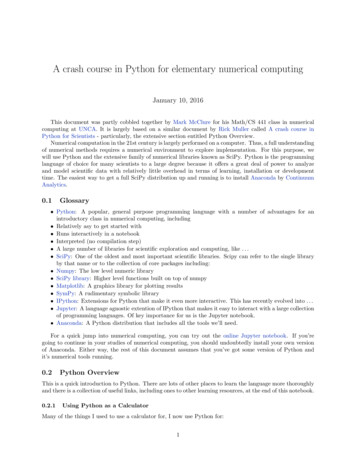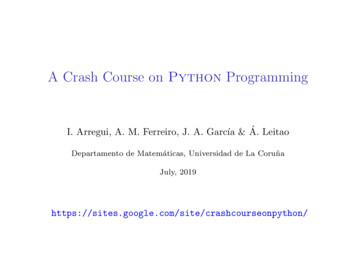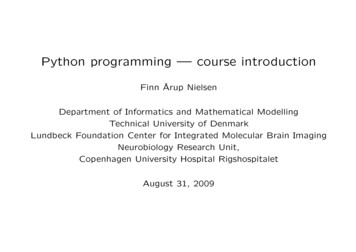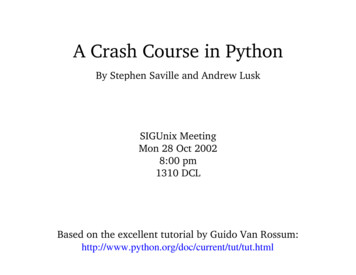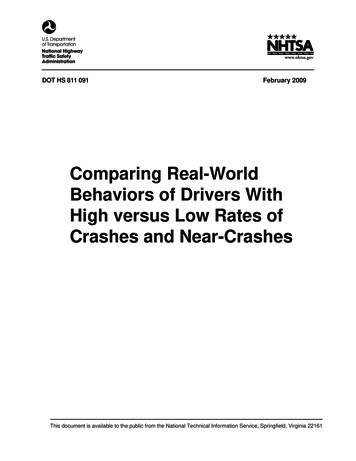
Transcription
Python Crash CourseJordan Boyd-GraberOctober 14, 2008Python is a very easy language to learn, and it has a wonderful collectionof libraries that seem to do everything (as implied by the XKCD comic). Inthis document, we’re going to run through the basics of Python and thenrun through an introduction to NLTK written by Nitin Madnani.1How to Interact with PythonIf Python is installed on your computer (and it’s in your path), go to the command line and type “python”. (Windows users: you might have to specifythe full path, as in -b-1226: jbg pythonPython 2.5.2 (r252:60911, Feb 22 2008, 07:57:53)[GCC 4.0.1 (Apple Computer, Inc. build 5363)] on darwinType "help", "copyright", "credits" or "license" for more information. print "Hello, world!"Hello, world!Once you see the Python prompt, you can start typing. Alternatively, youcan specify a Python program as the input to the Python program, and it runeverything written in the Python program. When you type anything on thisprompt, Python immediately interprets it and spits out the resulting value.This allows us to write programs really quickly and get instant feedback.2DatatypesThe primary data types you need to know in Python are integers, floats,strings, lists, and dictionaries.1
python.png (PNG-Grafik, 518x588 Pixel)http://imgs.xkcd.com/comics/python.pngint Integers are counting numbers, positive and negative. Note that whenyou divide one integer by another, you always get an integer. This isoften a problem when you’re computing probabilities. 22/731 von 19/24/08 10:00 PMfloat Floats are numbers that can be expressed as a fraction. float(22) / float(7)3.1428571428571428Note that I could have written this as 22.0 / 7.0 and still gotten theright answer, as 22.0 cannot be an integer. The operator ”float” allowsme to convert from an integer to a float. In general, using the name ofa data type as an operator on a data value, allows you to convert onetype of data into another. This is also how functions are called.string We’re going to work quite a bit with strings. A string is simply abunch of characters. Whatever you can type on your keyboard. Thenice thing about python is that every string object has a wide range offunctions built in:2
s " I am the very model of a modern Major-General " s.strip()’I am the very model of a modern Major-General’ s.find("am")3 s.replace("modern Major-General", "Gilbert caricature")’ I am the very model of a Gilbert caricature ’Notice that we also used assignment in order to make “s” mean thestring that we specified. Instead of writing that whole long string eachtime, we can just write “s” instead.list A list is an ordered collection of data (of any type). A string is verymuch like a list with extra functions thrown in. Both lists and stringscan access using the accessor []. If we turn a string into a list, we justget a list of all the characters in the string, but there are better waysto turn a string into a list (especially via NLTK). l range(10) l[0, 1, 2, 3, 4, 5, 6, 7, 8, 9] l[4]4 list(s)[’ ’, ’I’, ’ ’, ’a’, ’m’, ’ ’, ’t’, ’h’, ’e’, ’ ’, ’v’, ’e’, ’r’, ’y’, ’ ’, ’m’, ’o’, ’d’, ’e’, ’l’, ’ ’, ’o’ s.split(" ")[’’, ’I’, ’am’, ’the’, ’very’, ’model’, ’of’, ’a’, ’modern’, ’Major-General’, ’’] "am" in s.split()True "Mikado" in s.split()False filter(lambda x: x ! "", s.split(" "))[’I’, ’am’, ’the’, ’very’, ’model’, ’of’, ’a’, ’modern’, ’Major-General’]We did a whole lot there. First, the “range” function allows you togenerate a list of integers. With one argument, it gives you all nonnegative integers less than that argument. The “split” function of astring allows you to break apart a string into a list where the elementswere separated by the argument of the split function in the originalstring. You can also ask if something is in a list (or a string) by usingthe keyword “in”. The “filter” function is pretty advanced, and I won’texplain it here, but I’m including it here for anyone from a functionalbackground to know that you can do it in python.dict Dictionaries are the awesomest thing in Python. This is basically ahash table at the very lowest level of the language. A dictionary storesa mapping between keys and values.3
d {} d[3] 4 d[3]4 d[2]Traceback (most recent call last):File " stdin ", line 1, in module KeyError: 2 d[3] 2 d[3]2You can have anything that’s hashable as a key, and anything as avalue. Note that if you put in a value for the same key twice, it willoverwrite the contents.3ControlThis brings us to one of the quirkiest features of Python: syntactic whitespace. You don’t tell your program what is part of a loop or a block of yourcode by using brackets, as in other languages. You use whitespace. Everything inside an if statement has to be at the same level of indentation. Youtell Python that you’re done by returning to the earlier indentation level. .Allsheeps clothing "wool"if "wolf" in sheeps clothing:print "RUN"elif len(sheeps clothing) 4:print "Haircut time"else:print "All is well"is wellIf blocks are only required to have an “if”, and everything else is optional. The end of each control line has a colon. For loops are also prettystraightforward; they iterate over the elements of a list: sum 0 for i in range(100):.sum i. print sum4950(Remember that range(X) generates a list of all the numbers less thanthe argument; a more memory efficient version of range for loops is “xrange”,but this likely won’t be a problem for a while.)4
4Functions you make yourself and functionsyou borrow import nltk, re sent "The quick brown fox jumped over the lazy dog" nltk.re show("(fox dog marzipan)", sent)The quick brown {fox} jumped over the lazy {dog} re.findall("(fox dog rat)", sent)[’fox’, ’dog’]We use the “from X import Y” construction to bring in code that otherpeople have written. Python looks for this code in all of the places listedin the environment variable “PYTHON PATH”; it will search subdirectories(as specified by the “.” so long as there is a “ init .py” file. Now we’llimport more code from NLTK. from nltk.tokenize import WordPunctTokenizer from nltk.stem import PorterStemmer tokenizer WordPunctTokenizer() porter PorterStemmer() . tokenize tokenizer.tokenize stem porter.stem def tokens(raw text):.tokens map(stem, tokenize(raw text)).return tokens. tokens("Mares eat oats, and does eat oats, and little lambs eat ivy; A kid’ll eat ivy too, wouldn’t you?")[’Mare’, ’eat’, ’oat’, ’,’, ’and’, ’doe’, ’eat’, ’oat’, ’,’, ’and’, ’littl’, ’lamb’, ’eat’, ’ivi’, ’;’, ’A’, ’kid’,We create two instances of a tokenizer and a stemmer, and then use their“tokenize” and “stem” functions to build a function of our own.We create a new function called “tokens” which takes all the tokens in astring and then stems them. “def” is the keyword used to let Python knowwe’re defining a new function. The parentheses tell the function takes a singleargument. We then write all the code that we want to run every time thefunction “tokens” is called. Note that the return keyword ends the executionof a function; if you don’t specify a return value, it returns ”None” (a specialvalue in Python).5Pointers to other material1. http://nltk.org/doc/api/5
2. http://www.umiacs.umd.edu/ nmadnani/pdf/crossroads.pdf3. http://openbookproject.net//thinkCSpy/4. http://docs.python.org/tut/6
Python Crash Course Jordan Boyd-Graber October 14, 2008 Python is a very easy language to learn, and it has a wonderful collection of libraries that seem to do everything (as implied by the XKCD comic). In this document, we're going to run through the basics of Python and then run through an introduction to NLTK written by Nitin Madnani.


